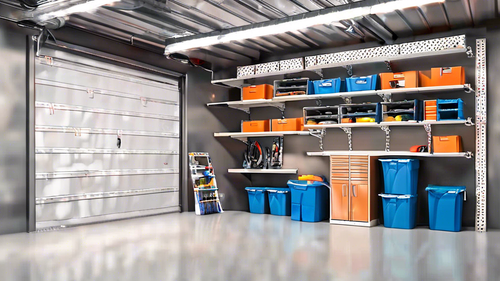
What's the Best Way to Organize Digital Files?
Share
To organize your digital files effectively, start by categorizing them by type, making it easy to manage and retrieve them. Next, set up a logical folder structure that mirrors your categorization, thinking of it as a digital filing cabinet. Consider using cloud storage services to sync your folder structure, allowing access across devices and locations. Implement a clear labeling and tagging system, using descriptive names with dates and keywords. Finally, schedule regular backups to safeguard your files from unexpected data loss. With these steps in place, you'll be well on your way to a streamlined system that's ready to be fine-tuned.
Key Takeaways
• Categorize files by type and group them into folders to ensure easy retrieval and management, avoiding digital clutter.
• Set up a logical folder structure mirroring categorization, with main categories and customizable subfolders for specificity.
• Use cloud storage services to sync your folder structure, allowing access to files across devices and locations, with benefits of data security and file sharing.
• Implement an effective labeling and tagging system with clear file naming conventions, descriptive names, and consistent use of tags to prevent digital chaos.
• Schedule regular backups based on your workflow to safeguard files from unexpected data loss, ensuring a well-structured system can withstand disasters.
Categorize Files by Type
Categorize your digital files into folders based on their file type, such as documents, images, videos, and audio files, to guarantee easy retrieval and management. This is the first step in taming the beast that's digital clutter. Think of it as a digital detox for your computer.
By grouping similar files together, you'll avoid the frustration of scrolling through a mess of files to find that one pesky document. As you categorize, you'll notice that your files fall into distinct categories. You might've folders for work projects, personal documents, and even memes (no judgment here!).
The key is to create a system that makes sense to you, so you can quickly locate the file you need. For instance, if you're a photographer, you might've separate folders for raw images, edited photos, and client deliveries. By doing so, you'll save time and reduce stress when searching for specific files.
Set Up a Folder Structure
Now that you've grouped your files by type, it's time to create a logical folder structure that mirrors your categorization system, allowing you to drill down to specific files with ease.
Think of this as building a digital filing cabinet, where each folder is a drawer and each subfolder is a smaller compartment within that drawer. To get started, prioritize folders by identifying the main categories that make sense for your files. For example, if you're a freelancer, you might've top-level folders for clients, projects, and administrative tasks.
Next, customize your hierarchy by creating subfolders that narrow down the scope of each main category. For instance, under the 'clients' folder, you could have subfolders for each individual client, with further subfolders for specific projects or deliverables.
The key is to create a structure that makes sense to you and is easy to navigate. Don't be afraid to get granular – the more specific your folders are, the faster you'll be able to find what you need.
And remember, a well-organized folder structure is like a well-organized mind: it's a beautiful thing!
Use Cloud Storage Services
With your folder structure in place, you can amplify its organizational power by syncing it with cloud storage services, which will provide you with seamless access to your files across devices and locations. This means you can ditch the pesky USB drives and emailing files to yourself (yes, we've all been there!).
Cloud storage services offer a range of benefits, including:
| Benefits | Description |
|---|---|
| Data Security | Your files are encrypted and protected from unauthorized access, giving you peace of mind. |
| File Sharing | Easily share files with colleagues, friends, or family, without the hassle of email attachments. |
| Remote Access & Collaboration | Access your files from anywhere, and collaborate on projects in real-time, making remote work a breeze. |
Label and Tag Files Effectively
By implementing a thoughtful labeling and tagging system, you'll be able to pinpoint specific files within your digital repository in a matter of seconds. It's like having a superpower, minus the cape and awkward superhero poses.
To achieve this level of digital wizardry, establish clear file naming conventions. This means using descriptive names, including dates, versions, and keywords. For instance, '2022_Marketing_Report_Final.docx' is way more informative than 'Report.docx'. You get the idea.
When organizing by date, consider using a 'YYYYMMDD' format to make sure files are listed in chronological order. This is especially helpful when tracking project progress or identifying outdated files.
You can also use tags or keywords to categorize files by project, client, or topic. Be consistent, though – inconsistencies can lead to digital chaos.
Schedule Regular Backups
Having organized your digital files, you're one step away from a complete digital filing system, but a well-structured system is only as good as its ability to withstand data loss, which is where scheduling regular backups comes in. You've worked hard to get your files in order, and now it's time to guarantee they're safe from unexpected disasters.
Here's what you need to do:
-
Determine your backup frequency: Will you back up daily, weekly, or monthly? Choose a schedule that fits your workflow and data protection needs.
-
Choose your backup method: Will you use an external hard drive, cloud storage, or a combination of both? Make sure you have a reliable method that can store all your files.
-
Test your backups: Don't assume your backups are working correctly – test them regularly to secure your data is recoverable in case of an emergency.
Frequently Asked Questions
How Do I Deal With Duplicate Files Taking up Storage Space?
"You're drowning in duplicates, wasting precious storage space! To optimize, identify duplicates using file management tools, then ruthlessly remove them - it's digital decluttering, baby! You'll be amazed at the space you'll free up."
Can I Use Emojis in File and Folder Names?
You wonder if emojis can spice up your file names, but beware: while they add creativity, they may sacrifice functionality and raise legal concerns, like trademark issues or encoding problems, so use them wisely!
What's the Best Way to Organize Files for a Team or Collaboration?
When you're working with a team, you'll want to create shared folders with clear labels and structures, so everyone's on the same page - it's like setting the table for a collaborative feast, minus the food coma afterwards!
How Do I Protect Sensitive Files From Unauthorized Access?
You're safeguarding sensitive files! First, encrypt your data to scramble prying eyes. Next, establish access control, locking down secure folders with password protection. You're basically building a digital Fort Knox – minus the gold, but plus total peace of mind!
Can I Use Automation Tools to Rename and Organize Files?
"Imagine having a personal file butler, like Jeeves from P.G. Wodehouse's novels! You can, by using AI tools for file organization, which automate renaming and categorizing, saving you time and reducing digital clutter - it's like having a superpower!"
Related Posts
-

Organize Your Garage Overhead Storage: A Quick Guide
As a homeowner, you know that keeping your garage organized can be a challenge. If your garage is anything like m...
-

Garage Roof Storage: Options and Considerations
The Unseen Space Saver As a homeowner, I've always faced the dilemma of finding ample storage space without clutte...
-

7 Kitchen Island Designs With Built-In Seating
You're looking for a kitchen island that not only provides additional counter space and storage but also incorporates...


